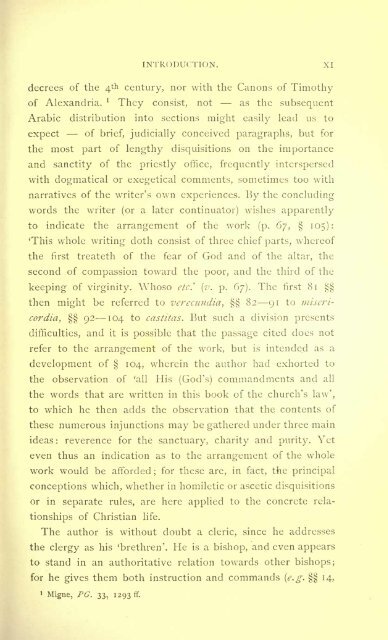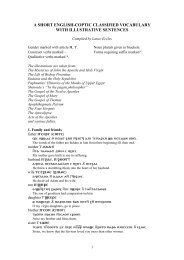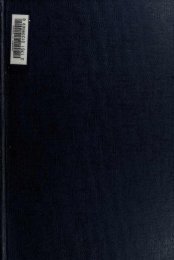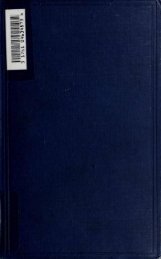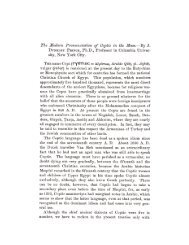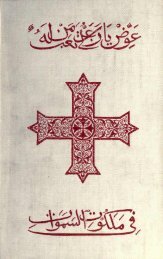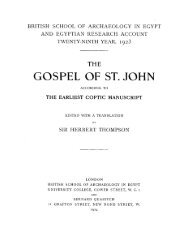- Page 5: WORKS ISSUED BY THE TEXT AND TRANSL
- Page 9 and 10: THE CANONS OF ATHANASIUS OF ALEXAND
- Page 11: Introduction. [W. R.] Table of Cano
- Page 14 and 15: VIII INTRODUCTION. narrating the hi
- Page 18 and 19: XII INTRODUCTION. 1 6, 1 8, 54, 61,
- Page 20 and 21: XIV INTRODUCTION. author to have ac
- Page 22 and 23: XVI INTRODUCTION. they sing not in
- Page 24 and 25: XVIII INTRODUCTION. enemies of the
- Page 26 and 27: XX INTRODUCTION. Lord in youth ( 97
- Page 28 and 29: XXII INTRODUCTION. agree with what
- Page 30 and 31: XXIV INTRODUCTION. These rules are
- Page 32 and 33: XXVI INTRODUCTION. laws , and (2) b
- Page 34 and 35: XXVIII manuscript INTRODUCTION. wil
- Page 36 and 37: XXX INTRODUCTION. not merely in its
- Page 38 and 39: XXXII TABLE OF THE CANONS. Can. 1 8
- Page 40 and 41: XX XIV TABLE OF THE CANONS. Can. 70
- Page 43: ARABIC TEXT.
- Page 46 and 47: K f. 944 ,V r \\\ .^i-.:^ <X
- Page 48 and 49: , ; ^, I^ LJ oAlt ^.JL^: L^-X-J ^o
- Page 50 and 51: K f. 96$ e) M Mv 1) M -f A (2Ux . /
- Page 52 and 53: K f. 974 3 !* 5 J * - w) Mp + "
- Page 54 and 55: R f I { ."* si.*! x> 5
- Page 56 and 57: H f. .5 < ir S L y,L\,]I Xx.
- Page 58 and 59: R f. 100* Ijt , Mv >. A:) M
- Page 60 and 61: R f. 1014 i XJJI a) M >. j4-
- Page 62 and 63: R f. 1024 a c<\pAKor|- C s)
- Page 64 and 65: K f. 1033 :AP r) R ^- p) R >
- Page 66 and 67:
R f. 1044 _o<^ bLJ Jj _xc ^,
- Page 68 and 69:
K f. 1054 ^-J- /* * _ rf <r*
- Page 70 and 71:
R 1064 A^ ! 6) R + -0 OJ PJo. d) M
- Page 72 and 73:
! o^J X) R A^i. y) R !.A^. 6) R d)
- Page 74 and 75:
f) j^ i) R -f- iC^UX- R >. r
- Page 76 and 77:
, lsA^Uu 13 I v_j^! 5 15 a) Canons
- Page 78 and 79:
(/ jb ,.,X* fe) rf) K >. cr
- Page 80 and 81:
jji ^v A* ^XL\i^. 1 /J ...v^*- * vv
- Page 82 and 83:
; _ _J l o x~ o J^c. xT s-JLiJ ^Ju
- Page 84 and 85:
x ..iXo oi- * 5 i -J^^vJ ! J&lt
- Page 86 and 87:
R f. IHfl x -- ^) R + i *) M Jal^J
- Page 88 and 89:
ff cr L< *J~ t AJs vc o Ai A
- Page 90 and 91:
R f. HO* 2 , m) R >. r) Mv +
- Page 92 and 93:
R f. a -.^ * V * t \ * .xXJ t? { V-
- Page 94 and 95:
^ * *^^ . cr j. liif s) M; SAi&
- Page 96 and 97:
K f. t/) /) y) M RM j. R S m) Mv ^
- Page 98 and 99:
K f. 1193 Ax* J. j^>* &g
- Page 100 and 101:
^-A-" -~-^> ^ ^ ( 3 O j
- Page 102 and 103:
M > . 0) Mp p) M + r) So RM;
- Page 105:
TRANSLATION OF THE ARABIC TEXT.
- Page 108 and 109:
they murmured against the Lord, and
- Page 110 and 111:
ing the ark unto his house, yet dur
- Page 112 and 113:
of thee that thou shouldst be witho
- Page 114 and 115:
10 art not able for this, wherefore
- Page 116 and 117:
12 the people. But the rest of the
- Page 118 and 119:
R f. 98* eyes, that they behold not
- Page 120 and 121:
i6 with the bells of gold that hung
- Page 122 and 123:
Rf. ioo/> *and i8 let not th
- Page 124 and 125:
For He teacheth, saying 3 2O , Ye b
- Page 126 and 127:
22 but that she may minister to the
- Page 128 and 129:
R f. 102^ 24 ( 12)..* The singers s
- Page 130 and 131:
Rf. io3/> He 26 loveth the p
- Page 132 and 133:
28 He may benefit mankind. Wherefor
- Page 134 and 135:
30 let him give unto him in secret,
- Page 136 and 137:
32 ( 32)- y No priest shall speak i
- Page 138 and 139:
34 Wherefore let not a priest be tr
- Page 140 and 141:
36 Rf. ioS<7 except he be an
- Page 142 and 143:
38 power over his own children, how
- Page 144 and 145:
40 they do at the Pascha, they shal
- Page 146 and 147:
( 63). o> All 42 the first-f
- Page 148 and 149:
44 upon them, n even as it rested u
- Page 150 and 151:
46 and multiply, because that the p
- Page 152 and 153:
4 8 she shall be put forth, as at f
- Page 154 and 155:
50 He became man, that He might sav
- Page 156 and 157:
the chief of the twelve tribes of I
- Page 158 and 159:
54 should give the first-fruits and
- Page 160 and 161:
56 For this did Jehoiada, the wise
- Page 162 and 163:
53 he could not flee, / because the
- Page 164 and 165:
K f. 6o virgins are greater and mor
- Page 166 and 167:
62 of the Lord. Anger not the bisho
- Page 168 and 169:
64 the solemnity of promises. And a
- Page 170 and 171:
66 their women. And if a nun be aki
- Page 172 and 173:
Rf. \2\b poor and the purity of the
- Page 174 and 175:
without difficulty find his object.
- Page 176 and 177:
72 I am acquainted with only three
- Page 178 and 179:
74 testify of him that he hath fast
- Page 180 and 181:
7 6 "Athanasius said, in the 7
- Page 182 and 183:
7* of the heathen. And if he go, he
- Page 184 and 185:
So The holy Athanasius saith, in hi
- Page 187 and 188:
That the foregoing Arabic version i
- Page 189 and 190:
33 book (Brit. Mus. Coptic Papyrus
- Page 191:
85 passages has recently been publi
- Page 194 and 195:
H MT[pOJfc.TT nMTie nujA j^[ r Hjfc
- Page 196 and 197:
(46). 9o OOC TliC\Vu\.c\ Tno XlC UJ
- Page 198 and 199:
UAp KAH UJc\T^\OTe H^HTOT HTMHCTXA
- Page 200 and 201:
A*\ \A Api n HToq KATA epo HOTC HOo
- Page 202 and 203:
R. III. OVROVI [c\piK iKe OTOTO CHA
- Page 204 and 205:
V. |K AH [Kene eqAiT ei jw.jw.oq KA
- Page 206 and 207:
B. VIII. ( <>*}. OT A
- Page 208 and 209:
THpOT iUJ THpCJ _iiOTno \ic i N. &a
- Page 210 and 211:
margin. B. XI. KOFIOC rtujojMiT nco
- Page 212 and 213:
B. Xlll. Kc\M Art OH UJOOR rtA\ 2 -
- Page 214 and 215:
B. XVIL;. ( 70 nortHpoc OTUJH TOT H
- Page 216 and 217:
B. XVI. ( 78). B. XXII. ( 80). B. X
- Page 218 and 219:
( 8 9)- B. XXI. ( 93)- TIArtTA nrtO
- Page 220 and 221:
B. XV. TIKOC ATiO OT Trt i Or K \HP
- Page 223 and 224:
N.B. The spaces enclosed in bracket
- Page 225 and 226:
curable, envied of all men, and tha
- Page 227 and 228:
121 reckoned of the number (aptQpdg
- Page 229 and 230:
I2 3 and if he yet be not sick, but
- Page 231 and 232:
125 0z/^(-measures), a great and a
- Page 233 and 234:
127 choose him being [God-]fearing
- Page 235 and 236:
I 2Q whole earth and the fulness th
- Page 237 and 238:
the goods of the church (sx.) serve
- Page 239 and 240:
133 that it may be for the gleaners
- Page 241 and 242:
135 [ I will give of my goods] unto
- Page 243 and 244:
37 [nor (ouc)*)] the grind-stone; f
- Page 245 and 246:
139 before the face of Elisha fEA/&
- Page 247 and 248:
APPENDIX B. Four leaves (pp. V{ ^^)
- Page 249 and 250:
them and let them anoint themselves
- Page 251 and 252:
BIBLICAL PASSAGES (a) quoted or ref
- Page 253 and 254:
Page Mat. V. 42 ...................
- Page 256 and 257:
Adultery. 34, 35, 130, 136. Adultre
- Page 258 and 259:
Mother of a convent. 58, 139. Mourn
- Page 260:
ERRATA. Page 5, note 13 read Ps. LX


